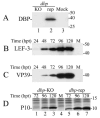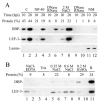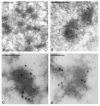Characterization of a baculovirus lacking the DBP (DNA-binding protein) gene
- PMID: 17449080
- PMCID: PMC2697660
- DOI: 10.1016/j.virol.2007.03.024
Characterization of a baculovirus lacking the DBP (DNA-binding protein) gene
Abstract
Autographa californica multiple nucleopolyhedrovirus (AcMNPV) encodes two proteins that possess properties typical of single-stranded DNA-binding proteins (SSBs), late expression factor-3 (LEF-3), and a protein referred to as DNA-binding protein (DBP). Whereas LEF-3 is a multi-functional protein essential for viral DNA replication, transporting helicase into the nucleus, and forms a stable complex with the baculovirus alkaline nuclease, the role for DBP in baculovirus replication remains unclear. Therefore, to better understand the functional role of DBP in viral replication, a DBP knockout virus was generated from an AcMNPV bacmid and analyzed. The results of a growth curve analysis indicated that the dbp knockout construct was unable to produce budded virus indicating that dbp is essential. The lack of DBP does not cause a general shutdown of the expression of viral genes, as was revealed by accumulation of early (LEF-3), late (VP39), and very late (P10) proteins in cells transfected with the dbp knockout construct. To investigate the role of DBP in DNA replication, a real-time PCR-based assay was employed and showed that, although viral DNA synthesis occurred in cells transfected with the dbp knockout, the levels were less than that of the control virus suggesting that DBP is required for normal levels of DNA synthesis or for stability of nascent viral DNA. In addition, analysis of the viral DNA replicated by the dbp knockout by using field inversion gel electrophoresis failed to detect the presence of genome-length DNA. Furthermore, analysis of DBP from infected cells indicated that similar to LEF-3, DBP was tightly bound to viral chromatin. Assessment of the cellular localization of DBP relative to replicated viral DNA by immunoelectron microscopy indicated that, at 24 h post-infection, DBP co-localized with nascent DNA at distinct electron-dense regions within the nucleus. Finally, immunoelectron microscopic analysis of cells transfected with the dbp knockout revealed that DBP is required for the production of normal-appearing nucleocapsids and for the generation of the virogenic stroma.
Figures







Similar articles
-
Identification of a domain of the baculovirus Autographa californica multiple nucleopolyhedrovirus single-strand DNA-binding protein LEF-3 essential for viral DNA replication.J Virol. 2010 Jun;84(12):6153-62. doi: 10.1128/JVI.00115-10. Epub 2010 Mar 31. J Virol. 2010. PMID: 20357098 Free PMC article.
-
Analysis of an Autographa californica multicapsid nucleopolyhedrovirus lef-6-null virus: LEF-6 is not essential for viral replication but appears to accelerate late gene transcription.J Virol. 2002 Jun;76(11):5503-14. doi: 10.1128/jvi.76.11.5503-5514.2002. J Virol. 2002. PMID: 11991978 Free PMC article.
-
The AcMNPV pp31 gene is not essential for productive AcMNPV replication or late gene transcription but appears to increase levels of most viral transcripts.Virology. 2007 Aug 15;365(1):34-47. doi: 10.1016/j.virol.2007.02.034. Epub 2007 Apr 30. Virology. 2007. PMID: 17467768 Free PMC article.
-
Isolation and characterization of the DNA-binding protein (DBP) of the Autographa californica multiple nucleopolyhedrovirus.Virology. 2008 Jan 20;370(2):415-29. doi: 10.1016/j.virol.2007.09.001. Epub 2007 Nov 1. Virology. 2008. PMID: 17935748 Free PMC article.
-
The adenovirus DNA-binding protein DBP.J Virol. 2024 Feb 20;98(2):e0188523. doi: 10.1128/jvi.01885-23. Epub 2024 Jan 10. J Virol. 2024. PMID: 38197632 Free PMC article. Review.
Cited by
-
Use of bacterial artificial chromosomes in baculovirus research and recombinant protein expression: current trends and future perspectives.ISRN Microbiol. 2012 Sep 12;2012:628797. doi: 10.5402/2012/628797. Print 2012. ISRN Microbiol. 2012. PMID: 23762754 Free PMC article.
-
Characterization of baculovirus constructs lacking either the Ac 101, Ac 142, or the Ac 144 open reading frame.Virology. 2007 Oct 10;367(1):187-95. doi: 10.1016/j.virol.2007.05.003. Epub 2007 Jun 21. Virology. 2007. PMID: 17585983 Free PMC article.
-
Production of baculovirus defective interfering particles during serial passage is delayed by removing transposon target sites in fp25k.J Gen Virol. 2012 Feb;93(Pt 2):389-399. doi: 10.1099/vir.0.036566-0. Epub 2011 Oct 12. J Gen Virol. 2012. PMID: 21994323 Free PMC article.
-
Genome Analysis of a Novel Clade II.b Alphabaculovirus Obtained from Artaxa digramma.Viruses. 2019 Oct 9;11(10):925. doi: 10.3390/v11100925. Viruses. 2019. PMID: 31601038 Free PMC article.
-
Characterization of AcMNPV with a deletion of ac68 gene.Virus Genes. 2008 Aug;37(1):119-27. doi: 10.1007/s11262-008-0238-9. Epub 2008 May 16. Virus Genes. 2008. PMID: 18483845
References
-
- Braunagel SC, Parr R, Belyavskyi M, Summers MD. Autographa californica nucleopolyhedrovirus infection results in Sf9 cell cycle arrest at G2/M phase. Virology. 1998;244:195–211. - PubMed
-
- Busch H. Ubiquitination of proteins. Methods Enzymol. 1984;106:238–62. - PubMed
-
- Campbell MJ. Lipofection reagents prepared by a simple ethanol injection technique. Biotechniques. 1995;18:1027–32. - PubMed
-
- Cunningham RP, Berger H. Mutations affecting genetic recombination in bacteriophage T4D. I. Pathway analysis. Virology. 1977;80:67–82. - PubMed
Publication types
MeSH terms
Substances
Grants and funding
LinkOut - more resources
Full Text Sources

